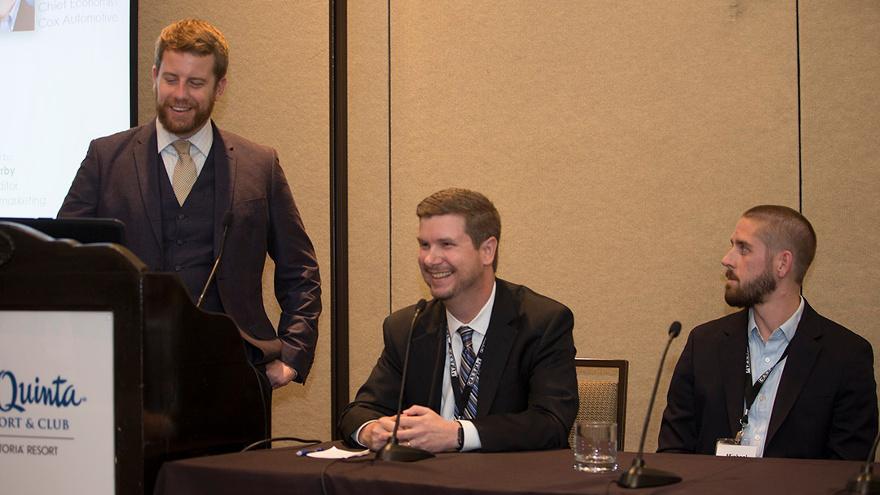Used-car demand bypasses ‘normal softening’

Cox Automotive chief economist Jonathan Smoke chuckles with Auto Remarketing senior editor Joe Overby and Moody's economist Michael Vogan during a panel discussion at Used Car Week 2017 in La Quinta, Calif. (Photo by Jonathan Fredin)
By this time of year, used-vehicle demand (unlike the weather) typically cools down a bit.
Not the case in 2018.
The “steady and strong” retail used-car market keeps chugging along and is likely to reach 39.5 million sales this year, then level out, according to Cox Automotive.
That figure would be an increase from 39 million used-car sales in 2017.
“The used market continues to be strong, powered by availability of off-lease vehicles that offer an alternative to the value-conscious and/or affordability-challenged buyer,” Cox Automotive chief economist Jonathan Smoke said during a conference call with reporters Tuesday.
“At Manheim, we saw weekly prices and dealer purchases increase in the final week of the month, which is typically an indicator of very strong retail demand,” Smoke said, referring to Cox Automotive’s chain of wholesale auto auctions.
“This is usually the time of the year when used vehicle demand softens a bit, following a tax refund-driven spring, but so far this year, we are not seeing signs of a normal softening,” he said.
Plateau at high level
And while there hasn’t been the usual seasonal slowdown in used sales, Smoke and the Cox Automotive team don’t anticipate the annual growth to escalate in the future, given that some of the pressures impact new-car sales have the potential to reach the used market, as well.
While declines are not expected, look for 39.5 million used-car sales to be the upper limit for now, as Cox Automotive analysts say the market is “plateauing” and is likely to reach the same tally next year.
“We basically have been seeing a fairly steady and strong level of used-vehicle demand that has been up substantially relative to the prior year. We saw, effectively, gains that were starting last spring,” Smoke said.
“We’ve reached a point though that it appears that the used-vehicle sales activity is plateauing. As we estimate used-vehicle sales, we’ve been tracking an annualized level of 39.4 million for the past six months,” he said.
“We do believe that if June comes in as strongly as we’re estimating that we might see that move up slightly to 39.5 million, but that’s likely the level at which we would expect to end the year.”
Despite potential thorns, no decline expected
The used-car market is not immune from some of the pressures on demand that have impacted new-car sales, like issues of affordability and financing, so there likely won’t be “further gains down the road,” in that market, Smoke said.
Additionally, some dealers — specifically independents — are starting to see some inventory challenges.
“In our Dealer Sentiment Index in the second quarter, independent dealers reported that their used-vehicle inventory was declining,” he said. “And so, of course, if we have declining inventory or declining availability relative to what we’ve been seeing in terms of growth, that will challenge us continuing to see more sales growth.
“But, that said, we are not forecasting a decline. We actually are forecasting 39.5 million used-vehicle sales for the year. And we are currently estimating that same number for next year. So, effectively, we’ve reached a level that we don’t think we can grow much from here, but very likely to remain at this level, given the very strong economic conditions that (Cox Automotive senior economist) Charlie (Chesbrough) mentioned,” Smoke said, referring to comments his colleague made earlier in the call about such factors as strong consumer confidence and strength in the labor market.
To add to Smoke’s point on inventory challenges, Chesbrough said that the used-car market is “having a real constraint of hangover effects from the Great Recession that’s leaving a real gap of supply in the marketplace for those 7- to 10-year-old vehicles, because we had such a massive decline in new-vehicle sales a decade ago and eight, nine years ago.”
He said: “There’s just not a lot of inventory out there and that’s putting a real squeeze on dealers to either buy older vehicles or buy newer vehicles. That supply is leaving a real impression in the marketplace.”
Used-car impact of tariffs
Another potential headwind to the used-car market could be the potential impact of tariffs.
Should new tariffs on imports happen, the actual impact could be quite varied; however, Cox Automotive said it could lead to a 5- to 25-percent gain in new-car prices.
Discussing tariffs in general, but tailoring it more to potential tariffs on imports, Smoke said: “We do think that an increase in new-vehicle prices brought on by tariffs is going to trickle into the used-vehicle market. It’s going to likely take several months and it’ll be reflected primarily in lower depreciation rates, rather than an immediate adjustment in used-vehicle prices.
“But there is a natural balance that the market, essentially, likes to see in between ages of vehicles. And so, if suddenly the new vehicle has a higher price, the used market will adjust to that,” Smoke said.
And the industry does not really gain from having higher prices on used cars, he said.
“The only constituency that really benefits from higher used-vehicle prices are finance companies, because they basically end up with higher residuals on lease vehicles, they end up with … lower losses on vehicles that go into collection mode,” Smoke said.
“But for a dealer and for a consumer, higher prices in both new and used vehicles is going to be a bad thing and will inevitably lead to fewer transactions. And fewer transactions inevitably lead to a smaller market, and a smaller market takes a dent out of the economy,” he said. “And so, it’s something that we don’t see a lot of positive silver linings in down the road.”


